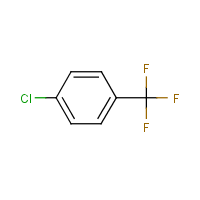1-Chloro-4-(trifluoromethyl)benzene
Agent Name
1-Chloro-4-(trifluoromethyl)benzene
Alternative Name
p-Chlorobenzotrifluoride
CAS Number
98-56-6
Formula
C7-H4-Cl-F3
Major Category
Other Classes

Synonyms
p-Chlorobenzotrifluoride; (p-Chlorophenyl)trifluoromethane; 1-(Trifluoromethyl)-4-chlorobenzene; 4-Chloro-alpha,alpha,alpha-trifluorotoluene; 4-Chlorobenzotrifluoride; Benzene, 1-chloro-4-(trifluoromethyl)-; Toluene, p-chloro-alpha,alpha,alpha-trifluoro-; alpha,alpha,alpha-Trifluoro-4-chlorotoluene; p-(Trifluoromethyl)chlorobenzene; p-Chloro-alpha,alpha,alpha-trifluorotoluene; p-Chlorotrifluoromethylbenzene; p-Trifluoromethylphenyl chloride; para-Chloro-alpha,alpha,alpha-trifluorotoluene; para-Chlorobenzotrifluoride; para-Chlorotrifluoromethylbenzene; [ChemIDplus] UN2234
Category
Halogenated Monoaromatics
Description
Liquid with a strong but not unpleasant odor; [Merck Index] Clear colorless liquid; [CAMEO]
Sources/Uses
Used as an intermediate for dyes and pesticides; Also used as a environmentally friendly solvent and dielectric fluid; [Merck Index] Used as a solvent for paints, toners, and coatings, especially in the automotive industry; Used by workers and consumers in cleaners, degreasers, stain removers, and sealants; [IARC monographs, volume 125]
Comments
A skin, eye, mucous membrane, and respiratory tract irritant; Inhalation of high concentrations can cause CNS depression; [CAMEO] A skin and eye irritant; In a two generation reproductive feeding study with rats, the NOAEL in F1 and F2 offspring was greater than or equal to the highest dose tested (45 mg/kg bw); No evidence of mutagenicity; [IUCLID] Effects observed from single oral dose in rats include ataxia, tremors, and decreased limb tone; Effects observed in F1 female rats in oral reproductive study include increase in SGPT, decrease in erythrocyte counts, and lesions in the lungs; Decrease in erythrocytes, hemoglobin, and mean corpuscular and packed cell volumes observed in male rats in 90 day oral study; Increased liver weights observed in both sexes; No evidence of mutagenicity; [EPA] Effects observed in feeding studies at 400 mg/kg include liver hypertrophy in rats and mice and adrenal changes in rats; Doses of 50 mg/kg caused nephropathy in male rats; [NTP]
Biomedical References
Exposure Assessment
Vapor Pressure
7.63 mm Hg
Lethal Concentration
LC50 (rat) = 22,000 mg/m3
Explanatory Notes
The Guide in the Emergency Response Guidebook is for "Chlorobenzotrifluorides." VP from ChemIDplus;
NFPA
high ambient temp required
Adverse Effects
Neurotoxin
Acute solvent syndrome
Hepatotoxin
Hepatoxic (a) from occupational exposure (secondary effect) or (b) in animal studies or in humans after ingestion
IARC Carcinogen
Possible (2b)
Diseases, Processes, and Activities Linked to This Agent
Diseases
Occupational diseases associated with exposure to this agent:
Processes
Industrial Processes with risk of exposure: